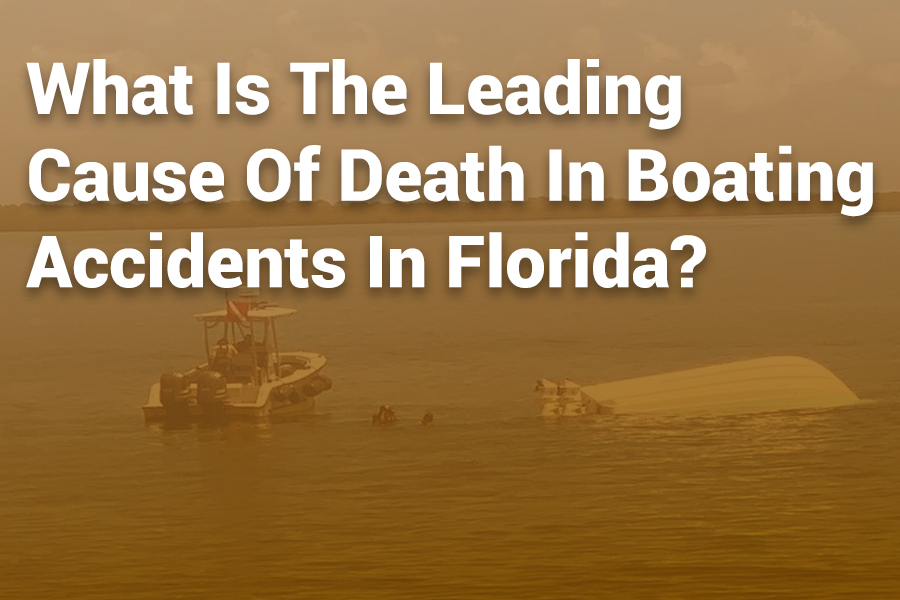Boating remains one of Florida’s favorite pastimes, with thousands of residents and visitors enjoying its vast waters every year. Unfortunately, Florida also leads the nation in boating accidents and fatalities.
Despite improvements in safety campaigns, many deaths still occur on the water, most of which could have been prevented. The biggest factor remains the lack of life jackets, leading to drowning as the primary cause of death. In this article, you will learn why drowning dominates boating fatalities in Florida, the other common contributing factors, and the safety measures that save lives.
Leading Cause of Death in Florida Boating Accidents
Florida’s warm climate, extensive coastline, and large boating population create both opportunities and risks. In 2022, the Florida Fish and Wildlife Conservation Commission (FWC) reported 735 boating accidents, resulting in 65 deaths and 457 injuries.
Drowning caused the majority of these fatalities, with 81% of victims not wearing life jackets. The evidence points to one central conclusion: while many issues contribute to boating deaths, drowning remains the leading cause in Florida.
Drowning as the Primary Risk
Most boating accidents do not instantly claim lives. Instead, victims often survive the initial collision or incident but lose their lives afterward because they cannot stay afloat. Life jackets play a crucial role in preventing drowning, yet many boaters still ignore them.
Florida data shows that the majority of those who drowned were not wearing flotation devices. A simple safety step could have changed the outcome in most cases.
This pattern has held steady over the years. In 2024, reports recorded 81 boating deaths in Florida. Once again, drowning remained the top cause. Accidents like capsizing, falls overboard, or collisions frequently led to drowning, and in almost every case, victims lacked life jackets.
Why Boaters Avoid Life Jackets
Understanding why people resist wearing life jackets sheds light on the persistent risk. Many boaters feel overconfident in their swimming abilities. Others view life jackets as uncomfortable, unnecessary, or unattractive. Some assume calm weather or familiarity with the water eliminates the need. Yet accidents often occur without warning, and alcohol or panic can quickly overwhelm even skilled swimmers. The refusal to wear flotation devices leaves boaters exposed to the deadliest outcome of accidents.
Alcohol Use and Its Deadly Role
Alcohol remains another leading factor in boating deaths. In 2024, alcohol contributed to at least 24 fatal boating accidents in Florida, making it the top contributing cause after drowning itself. Impaired judgment, slower reaction times, and poor coordination significantly raise the risk of falling overboard or crashing into obstacles. Combining alcohol with the absence of life jackets often proves fatal.
Boating under the influence is illegal in Florida, yet enforcement cannot prevent every instance. Many boaters underestimate how quickly alcohol impairs their ability to operate safely. Since boats move differently than cars, some also believe the risks are lower, when in reality the water environment amplifies the danger.
Operator Inattention and Improper Lookout
Besides alcohol and life jacket neglect, operator error stands out as a major contributor. The Garvin Legal report highlights operator inattention and improper lookout as significant factors in fatalities. Distractions from phones, conversations, or simply relaxing while steering a vessel reduce awareness of hazards. With crowded waterways, an inattentive moment can lead to collisions or falls.
Improper lookout refers to the failure to scan for obstacles, swimmers, or other vessels. Inexperienced operators often misjudge distances or ignore boating rules. These oversights frequently trigger the very accidents that result in drownings.
Excessive Speed and Reckless Behavior
Speeding on the water has similar risks to speeding on the road. Boats require longer distances to slow down, and wakes can destabilize smaller crafts. Excessive speed leads to collisions, capsizing, or ejections from the vessel.
In 2024, Florida recorded at least eight fatal accidents caused by excessive speed. The combination of reckless driving and lack of safety gear makes accidents far more deadly.
Equipment Failures and Lack of Preparedness
Although less common, mechanical failures and lack of safety equipment still play roles in fatalities. Boats without functioning lights, radios, or engines can become stranded in dangerous waters. Equipment like fire extinguishers, horns, and life rings also make a difference in emergencies. However, when boaters neglect safety checks or skip carrying essential gear, small issues escalate quickly.
Weather and Hazardous Conditions
Florida’s weather can change rapidly, especially during summer storms or hurricane season. Rough waters, strong winds, and poor visibility raise the chance of capsizing or collisions. In 2024, at least three boating deaths in Florida linked directly to bad weather conditions. Many boaters underestimate these risks or fail to check forecasts before heading out. Safety campaigns stress preparation, but poor judgment continues to cause preventable deaths.
The Role of Education and Training
Lack of experience and training magnifies all other risks. Florida requires boater education for certain operators, yet many remain untrained. In 2024, operator inexperience contributed to at least four fatal accidents.
Proper training teaches operators to maintain lookout, avoid speeding, check equipment, and respect weather warnings. Education also emphasizes the life-saving importance of flotation devices. Without these lessons, operators expose themselves and passengers to higher danger.
Safety Campaigns and Progress
Florida has responded with initiatives like the “Wear It Florida” campaign, urging life jacket use. Law enforcement also increases patrols during busy seasons, checking for intoxicated operators and unsafe boats. These measures have helped spread awareness, but the numbers show more work remains. Drowning continues to dominate fatalities year after year, proving that changing behavior is more difficult than simply spreading information.
Real-Life Consequences
Every statistic represents a person lost and a family devastated. Survivors often recount how quickly accidents unfold. A fun afternoon can turn tragic within seconds if a passenger falls overboard without a life jacket. Even strong swimmers can become exhausted or disoriented. Alcohol, panic, or injuries make survival nearly impossible without flotation. These stories underscore why safety measures matter more than confidence or convenience.
Preventing Drownings in the Future
The solution is clear, though not easy. Increasing life jacket use remains the most direct way to prevent deaths. This requires shifting boating culture toward safety-first habits. Families can set an example by wearing life jackets even in calm waters. Boating groups and rental companies can enforce stricter rules. Education programs must continue emphasizing how quickly accidents become deadly without flotation.
Stronger enforcement of alcohol restrictions also helps. Sobriety checks on waterways save lives just as DUI checkpoints do on roads. Combined with speed enforcement, weather awareness campaigns, and stricter training requirements, these steps create safer boating environments.
The Cultural Challenge
Changing habits is the hardest part. Many boaters view safety gear as optional. Others resist government rules on personal freedom. Yet the evidence is undeniable: most boating deaths are preventable, and the leading cause—drowning—almost always comes down to not wearing a life jacket. Safety campaigns must find ways to make life jackets not just mandatory but normal. When safety becomes part of boating culture, deaths will decline.
Key Takeaways
- Florida leads the nation in boating deaths.
- Drowning is the leading cause, often due to lack of life jackets.
- Alcohol, operator inattention, speed, and weather contribute significantly.
- Education, enforcement, and cultural change are vital for prevention.
Final Thoughts
Florida’s waters will always attract boaters, but safety must take priority. Data from 2022 to 2024 makes the pattern unmistakable: drowning remains the leading cause of death in boating accidents across the state.
Most of these deaths occur because victims did not wear life jackets. Alcohol, inattention, speed, and weather add to the risks, but drowning dominates the statistics. The path forward involves stricter enforcement, broader education, and above all, consistent life jacket use. By addressing these issues, Florida can keep boating enjoyable without letting preventable tragedies continue unchecked.









